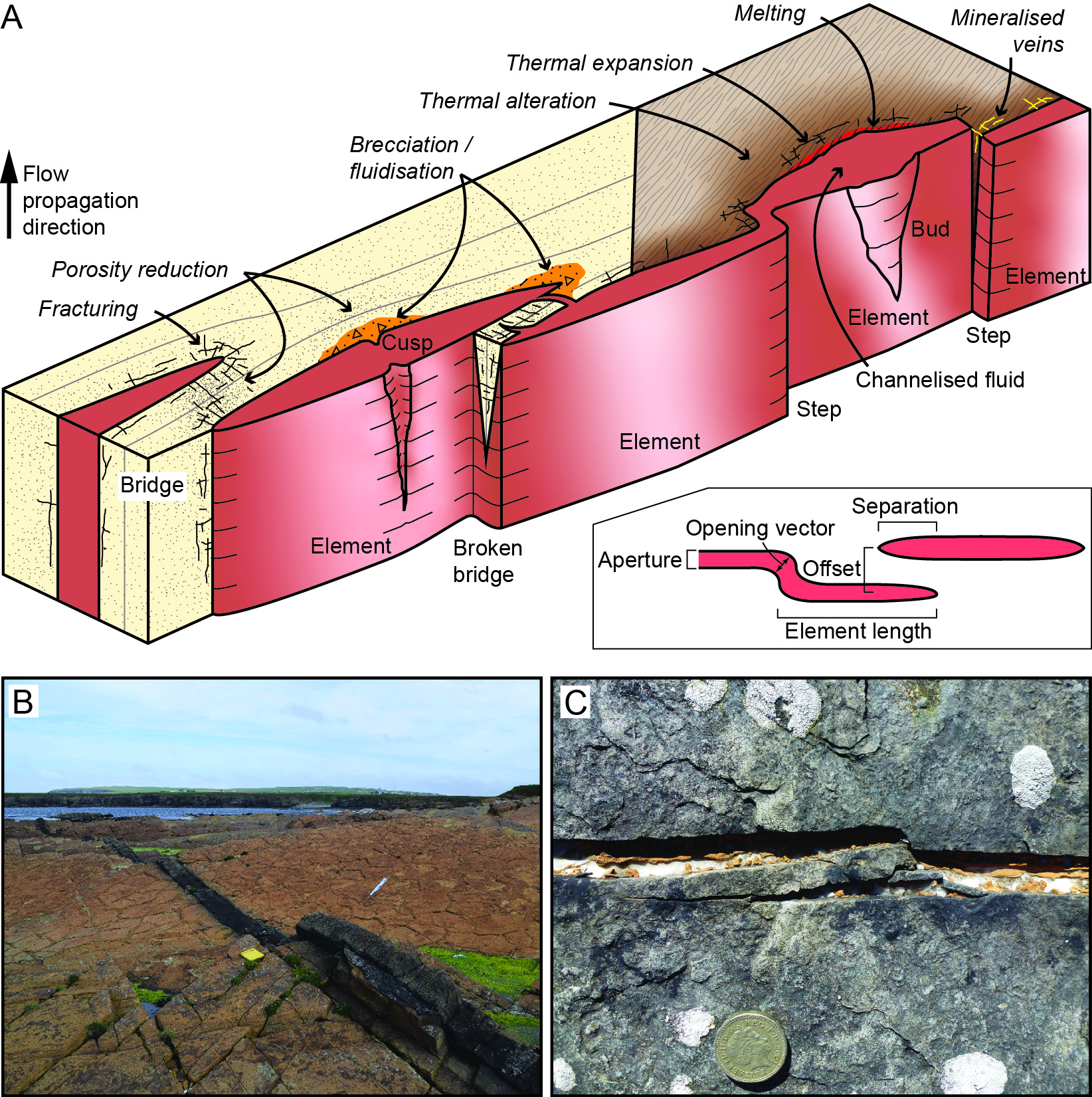Exploring the segmented structure of igneous sheet intrusions and mineral veins
Summary
Sheets of magma (dykes and sills) and mineralising fluids (veins and pegmatites) are injected through Earth’s crust in many geological settings. Most of these igneous sheets and mineral veins, regardless of scale or composition, are segmented into discrete elements, which may be separated by intervening bridges of host rock or connected via ‘steps’ or ‘broken bridges’ (Fig. 1) (Magee et al., 2019). The geometry of elements and their connectors influences the overall shape of sheet intrusions and limits the dynamics of internal fluid flow, which affects magma transport, volcanic eruption siting, and mineral/metal distributions (e.g., Magee et al. 2016a, Magee et al., 2016b). Furthermore, the presence and geometry of bridges between elements also allows fluid flow in the surrounding rock. However, very few studies have quantified the geometry of elements and connectors (e.g., aperture, offset; Fig. 1) meaning that for any sheet intrusion we cannot predict their subsurface distribution or style.

Impact
The geometry of sheet intrusions controls the subsurface distribution and storage of magma, ultimately influencing its eruption potential, and the location of associated mineral and metal deposits crucial to a sustainable energy transition. A key challenge that thus spans structural geology, volcanology, and ore geology disciplines involves quantitatively analysing the 3D geometry of sheet intrusion elements and connectors. With such information we can build predictive models that forecast the subsurface distribution of magma, help identify new mineral/metal deposits, and constrain fluid flow around sheet intrusions. Your findings will therefore be of interest to academics, industries (e.g., mining, geothermal), volcano observatories, and policy-makers worldwide. You will communicate findings through scientific papers, presenting at national and international conferences, and other avenues.
Objectives and plan
You will quantify the 3D geometry of sheet intrusion elements and connectors using a variety of geological and geophysical methods. Specifically, the PhD will involve fieldwork to digitally map a variety of different sheet intrusions, including: (1) dykes exposed on a wave-cut platform in Birsay, Orkney (Fig. 1B) (Healy et al., 2018); (2) pegmatites and dykes in the Lewisian Gneiss of NW Scotland; (3) calcite-dolomite veins at Wick, N Scotland (Fig. 1C); and (4) lead-zinc mineral veins in the southern Pennines, England. Fieldwork will be complemented by seismic reflection interpretation of buried, large-scale igneous sills (Kopping et al., 2022). Depending on your interests, there are also opportunities to explore how sheet segmentation affects internal flow dynamics and/or external host rock deformation using Scanning Electron Microscope techniques to analyse collected samples, and/or devise and conduct small-scale geophysical surveys (seismic reflection, ground-penetrating radar, magnetics) of the Birsay dykes to image their subsurface 3D geometry. The PhD project could include:
Year 1
Core
- Compile literature data on sheet intrusion and mineral vein geometries.
- Conduct field campaigns – digitally map and measure sheet intrusions and mineral veins.
Options
- Collect and prepare samples for thin section analysis.
- Plan Birsay geophysical surveying.
Year 2
Core
- Conduct additional field campaigns, revisiting sites to collect more data based on Year 1 findings.
- Seismic interpretation of large-scale intrusions.
Options
- Thin section analysis.
- Conduct Birsay geophysical surveying based on site visit in Year 1.
- Process and interpret Birsay geophysical surveys.
Year 3
Core
- Synthesise data from field campaigns
- Complete seismic interpretation of large-scale intrusions.
- Write-up.
Options
- Thin section analysis.
- Interpretation of Birsay geophysical surveys
Training and opportunities
You will be based in the Institute for Geophysics and Tectonics at the University of Leeds and receive training in field skills, seismic interpretation, and geophysical surveying and/or thin section analysis depending on your interests. Additional training in scientific writing, statistics and data analysis, problem-solving, time management, and developing independent research planning skills will also be provided by us and the YES DTN program. Through this training, you will become a confident and independent researcher with transferable skills applicable to both academic and non-academic jobs. Within Leeds, you will have the opportunity to interact with the Volcanology and Tectonics research groups.
Applicant Background
This project would suit candidates with a background in geology or geophysics, and specific interests in volcanology or structural geology. We encourage applicants from all backgrounds.
Fit to NERC Science
This project constitutes fundamental research into Earth processes and therefore fits well within the remit of NERC science. The project fits into the research areas of Earth Resources, Volcanic Processes, Geohazards, and Tectonic Processes. The School also hosts numerous staff from the NERC-funded Centre for the Observation and Modelling of Earthquakes and Tectonics (www.comet.nerc.ac.uk), with whom you will be able to interact.
References
Healy, D., Rizzo, R., Duffy, M., Farrell, N., Hole, M., and Muirhead, D., 2018, Field evidence for the lateral emplacement of igneous dykes: Implications for 3D mechanical models and the plumbing beneath fissure eruptions: Volcanica, v. 1, no. 2, p. 85-105.
Köpping, J., Magee, C., Cruden, A. R., Jackson, C. A.-L., and Norcliffe, J., 2022, The building blocks of igneous sheet intrusions: insights from 3D seismic reflection data: EarthArXiv.
Magee, C., Muirhead, J., Schofield, N., Walker, R. J., Galland, O., Holford, S., Spacapan, J., Jackson, C. A. L., and McCarthy, W., 2019, Structural signatures of igneous sheet intrusion propagation: Journal of Structural Geology, v. 125, p. 148-154.
Magee, C., Muirhead, J. D., Karvelas, A., Holford, S. P., Jackson, C. A. L., Bastow, I. D., Schofield, N., Stevenson, C. T. E., McLean, C., McCarthy, W., and Shtukert, O., 2016a, Lateral magma flow in mafic sill complexes: Geosphere, v. 12, no. 3, p. 809-841.
Magee, C., O’Driscoll, B., Petronis, M. S., and Stevenson, C. T. E., 2016b, Three-dimensional magma flow dynamics within subvolcanic sheet intrusions: Geosphere, v. 12, no. 3, p. 842-866.
